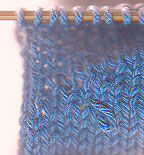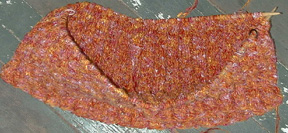Short Rows are used to create dimensional knitting - it can add either curves to flat knitting or depth.
The human figure is not flat, even though our clothing often is - to shape clothing and make it more flattering (or just plain more comfortable), short rows can be used to add roundness for the bust, stomach, and upper back of a garment while maintaining the same distance at the sides. In other words, a piece might have 20 rows at the edges and 30 rows in the middle - Huh?
This photo has three sets of short rows:

The are 18 MORE rows in the center than on the sides, causing it to arch. See how we get short row heels on socks - we knit a little pouch like this for the base of the heel. This is only one of many shapes you can create with short rows.
The Short Row Exercise
I really want you to do this little sample so you will understand short rows - it won't take long - I promise :-)
With smooth yarn and appropriate needles - my samples are done with dishcloth cotton - cast on twenty stitches.
1. knit across the row - 20 stitches. Turn and
2. purl across the row - 20 stitches. Turn and
3. knit 18 stitches. Stop - breath - you have two stitches left unknitted. They will be staying right where they are.
4. Turn your knitting around so you are holding it facing the purl side. There are two stitches on your right needle and 18 on the left. The little gap between the right and left needle is where a hole "may" develop as you work short rows. This little opening is what people are trying to prevent by wrapping or using yarn overs while short rowing. We are not going to worry about it - this is my We Don't Need No Stinkin' Wraps Method of short rowing. So - slip the first stitch purlwise - tighten the yarn around the neck of this stitch as much as you can. Knit the next stitch. Stop here and look at your work from the front (knit) side.

The picture shows the two unworked stitches on the left, then the little gap, then the slipped stitch, then a knit stitch. Flip back to the purl side (we were just visiting the front, not doing anything.) Purl 14 stitches - stop. You should have two stitches remaining on the left needle. They will be staying right there. Turn your work and
5. Slip the first stitch (purlwise so it stays seated on the needle the same way), knit 13 stitches - stop. We are going to turn again. Notice you have four stitches on the left needle. We will be leaving two more stitches behind each time we turn. Two stitches is an arbitrary number - it could be five, it could be ten - it depends on how steep you want your curve to be.
Note: In the T-Top pattern I want to hide my turn between a knit and a purl (we are doing k2p2 ribbing) because the stitches are often a bit looser there anyway. YOU decide where you want to position them because YOU will always be the one adding them to a pattern.
6. Turn, slip the first stitch purlwise. Tighten the yarn. Purl 11 stitches. Stop - there are 4 stitches on the left needle. Turn.
7. Slip the first stitch. Knit nine stitches. Stop. Turn.
8. Slip one, purl seven. Stop. Turn.
At this point there are six unworked stitches at each end of the row. Having done enough short rows for our example, we are returning to regular knitting.
9. Knit all 13 stitches, pulling your yarn as tightly as possible as you knit across the last seven stitches. You should have all 20 stitches on your right needle. Turn.
10. Purl across the row, knitting tightly across the last seven stitches. You have purled across all 20 stitches.
Turn and work an additional four rows in stockinette - knit on the front, purl on the back.

Notice the loose/larger stitches where I turned . . . I can fix them the same way I fix ANY loose stitches in my knitting - by pulling up the looseness and distributing it across the row (washing and blocking will further hide any looseness.)

I've hooked the loose stitch with an extra needle and pulled the loose yarn up into a loop. Next I will follow the path of the yarn and move the looseness toward the center of the row by pulling on part of a stitch a little further to the right.

In the next picture, I have "fixed" all the stitches that looked loose. You can clearly see the crescent of short rows - and I don't see any gaps.

Having tried the various short row wrapping methods and acknowledging the difficulty of finding/seeing/picking up the wraps - I would much rather spend a few minutes tightening some stitches than fiddling with when and how to wrap. Not to mention - even with wrapping, there are still loose stitches that need to be tightened. Here is a comparison of all three methods:

Top - Zilboorg's yarn over method from the Knitting Anarchist.
Middle - My No Stinkin' Wraps method.
Bottom - Standard short row wrapping.
All of them had loose stitches tightened to improve the look.
To learn how to do traditional short row wrapping - check your favorite knitting reference book :-)I did not find a lot of great photo/instructions on the net for short row wrapping but here is one - scroll down the page.
Back to our T-Top
Why all this talk about short rowing? I don't like to always be tugging on the back of my sweater so I usually put some short rows at the bottom of the back. When I was ready to do the short rows, I worked half way across the piece until I reached my side marker - because I looked at the pattern and figured out that the first half of the stitches was going to be the front and the second half was going to be the back. Going a few stitches past the marker, I turned the work and did six short rows, moving over two stitches each time, just like the example (only the rows were longer :-)

The back of my sweater is now longer than the front. I will probably do a couple more short rows up near the top of the back. If you have more of a chest than I do, you will want to put your shorts rows at the widest part of your bust. Lily Chin did a great article in one of the knitting magazines a few years ago on adding short rows to make sweaters fit better - maybe one of you knows which magazine?
Some people love to play with short rows - if you ever run into the Queen of Short Rows - Heather, she will tell you all about her adventures with them.
Questions?












